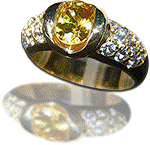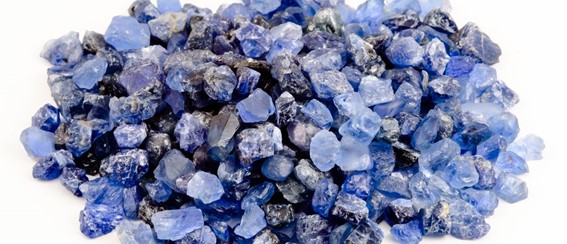Contrary to many peoples’ beliefs, not all sapphires are blue! Before making a choice of which type and color of sapphires to purchase, some basic information about sapphires in their vast array of colors is presented here.
Blue Sapphires Aren’t Nature’s Only Treasure

Green gold and blue sapphires When you wish to purchase a beautiful gemstone like a sparkling blue sapphire, please consider the other sapphires colors and shades available, these stunning gems occur in many colors: to name a few:blue, green, yellow, pink, bi-color ( known as partis) just about every shade of the rainbow! It’s easy to admire a lovely gemstone in a perfect setting, or even a loose stone, what isn’t commonly known is that it isn’t the color of the stone that makes it a sapphire or a ruby or an emerald, etc., but its chemical composition, depending upon what mineral was present in the ground where the sapphire was formed. Thus, while blue sapphires may be the best known, colored sapphires other than blue are just as spectacular!
All gemstones are classified by groups, species and varieties; various minerals influence the color of the stone. For example, rubies are the red variety of the species corundum; any other color of this species is classified as a sapphire. The superlative blue sapphires of Australia get their color from the iron in their native soil. Different colored sapphires such as green, pink, yellow, teal, orange, purple and multi-color known as partis emerge from different lighting conditions and different minerals in the soil. Americans are most familiar with the deep blue sapphire; yet even these blue sapphires vary in light to dark hues.
Sapphires in colors other than blue are exquisite and exciting to see for the first time! These Australian colored sapphires are often parti-colored with mesmerizing mixtures and swirls of blue, green and yellow. The color variations are endless; an example of just how creative nature can be in delighting the eye.

Gemologists tell us that the same gemstone, like a sapphire, has different colors because their atomic structure isn’t quite the same; change but a single atom and a blue sapphire becomes green, pink, or even orange-pink called a “Padparadscha” colored sapphire. Australia has a fondness for the lovely green or teal colored sapphire that flourishes in some mines, while the subtle beauty of the pink sapphire is more commonly found in Africa and Sri Lanka. The Ceylon blue sapphire is a pale blue that, at first glance, may seem to be an aquamarine.
Golden yellow Sapphire Just as pearls are white, ivory, pink or black, fresh-water or salt-water, the traditional, best known blue sapphire is just the beginning of the vast array of brilliant colors of this beloved gemstone. Wearing a different colored sapphire is a pleasant experience, just knowing that you’re wearing something unique, designed perfectly by the elements of light and earth, and polished to perfection by man.
